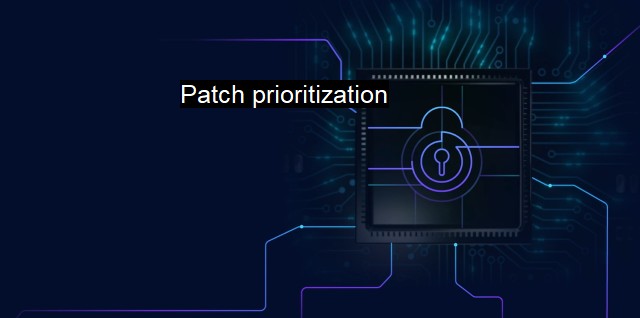What is Patch prioritization?
Importance of Patch Prioritization in Cybersecurity: Understanding the Processes and Techniques
Patch prioritization is a critical aspect in the realm of cybersecurity and antivirus safeguards. It refers to the process of identifying, ranking, and prioritizing the application of software or operating system updates—known as "patches"—in order to mitigate vulnerabilities and mitigate the possibility of hacking or other malicious attacks.In general, a patch is a piece of software designed to update, fix, or improve a computer program, including fixing security vulnerabilities. These vulnerabilities are points of weakness that can be exploited by threat actors to disrupt, gain unauthorized access or control over a data system or network. Unpatched vulnerabilities put systems at risk for malware, ransomware and various types of cyber-attacks that can result in a devastating data breach.
When it comes to patching, it is not just a matter of simply applying all patches right away. Some patches address more critical threats than others, some are applicable to only certain systems or software, and some could potentially create new issues if applied improperly or in the wrong sequence. Thus, a system is required that accurately identifies and rates the severity of threats and the necessity of patches, that is where patch prioritization comes in.
Patch prioritization helps to systematically organize and rank the order of importance, considering the severity or risk level of vulnerabilities. It helps organizations focus their resources where they will provide the most immediate and significant benefit — addressing the most dangerous threats first. This system increases efficiency by reducing downtime and offers economic benefits by allowing better allocation of resources.
Patch prioritization mainly focuses on severity, exploitability, and the impact of the threat, following certain classifications. Common Vulnerability Scoring System (CVSS) is a widely recognized method used to classify the severity of cybersecurity vulnerabilities. It provides scores from zero (least dangerous) to ten (most dangerous), which support the process of patch prioritization.
It's critical to keep in mind that CVSS and other scoring systems can only offer a relative score, with no definitive interpretation of how dangerous a vulnerability is or how urgently it needs patching. Therefore, patch prioritization is often supplemented with other factors. These might include an understanding of the organization’s unique environment and working practice, awareness of any active threats relating to particular vulnerabilities, and knowledge of the probable harm if a vulnerability is exploited.
In the world of antivirus protections, patch prioritization also plays a vital role. Protection software frequently gets updated to combat new viruses, malware, rootkits, worms, ransomware, and so on, that threat actors develop. To keep a system secure against these threats, these patches need to be timely applied, and just like in general cybersecurity, they need to be prioritized because they don't carry the same risk level.
The prioritization process in the context of antivirus patches typically includes determining if a patch is relevant to the system, determining the role of the patch in reducing or mitigating potential security risks, the business impact if a patch is not applied timely, and the implementation costs.
In closure, patch prioritization is an imperative cybersecurity process that can daunting in its complexity. with a well-established strategy in place, organizations can optimize based on the potential threats they face and proactively secure themselves. The process not only manages risks but also promotes efficient resource allocation reducing unnecessary software maintenance costs and minimizing disruptions for users. patch prioritization guarantees the upkeep of software and antivirus programmes, thereby enhancing the security of systems, providing confidence to users, customers, and stakeholders.

Patch prioritization FAQs
What is patch prioritization in cybersecurity and antivirus?
Patch prioritization is the process of determining the order in which patches for software vulnerabilities should be applied based on their level of criticality and the potential impact on an organization's network and systems. This helps ensure that the most important patches are applied first to minimize the risk of cyber attacks.Why is patch prioritization important in cybersecurity and antivirus?
Patch prioritization is important because cybercriminals actively target known software vulnerabilities to gain unauthorized access to systems and networks. By prioritizing patches based on their level of criticality and potential impact, organizations can reduce the risk of cyber attacks and protect their assets from potential threats.How is patch prioritization performed in cybersecurity and antivirus?
Patch prioritization is typically performed using vulnerability scanners that identify software vulnerabilities and assign a risk score based on their severity and impact on the organization. IT professionals then use this information to prioritize patches based on their risk score and the potential impact on the organization's network and systems.What are some best practices for patch prioritization in cybersecurity and antivirus?
Some best practices for patch prioritization include regularly scanning for vulnerabilities, developing a risk-based approach to patching, prioritizing critical patches first, testing patches before deploying them, and keeping track of patch management metrics to monitor progress and identify areas for improvement. It's also important to have a comprehensive patch management policy in place to ensure that patches are applied consistently, and that roles and responsibilities for patch management are clearly defined.| | A | | | B | | | C | | | D | | | E | | | F | | | G | | | H | | | I | | | J | | | K | | | L | | | M | |
| | N | | | O | | | P | | | Q | | | R | | | S | | | T | | | U | | | V | | | W | | | X | | | Y | | | Z | |
| | 1 | | | 2 | | | 3 | | | 4 | | | 7 | | | 8 | | |||||||